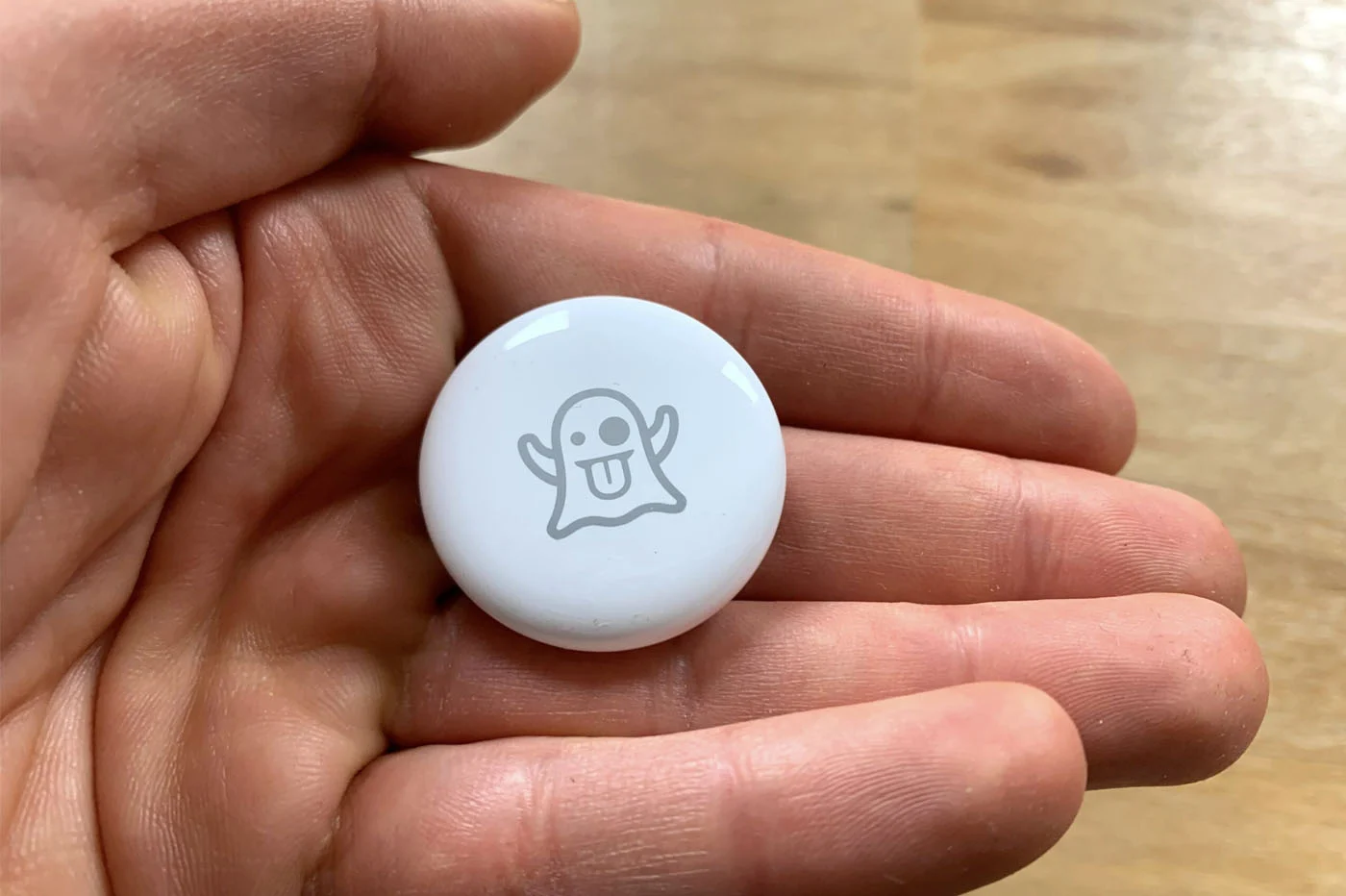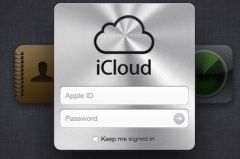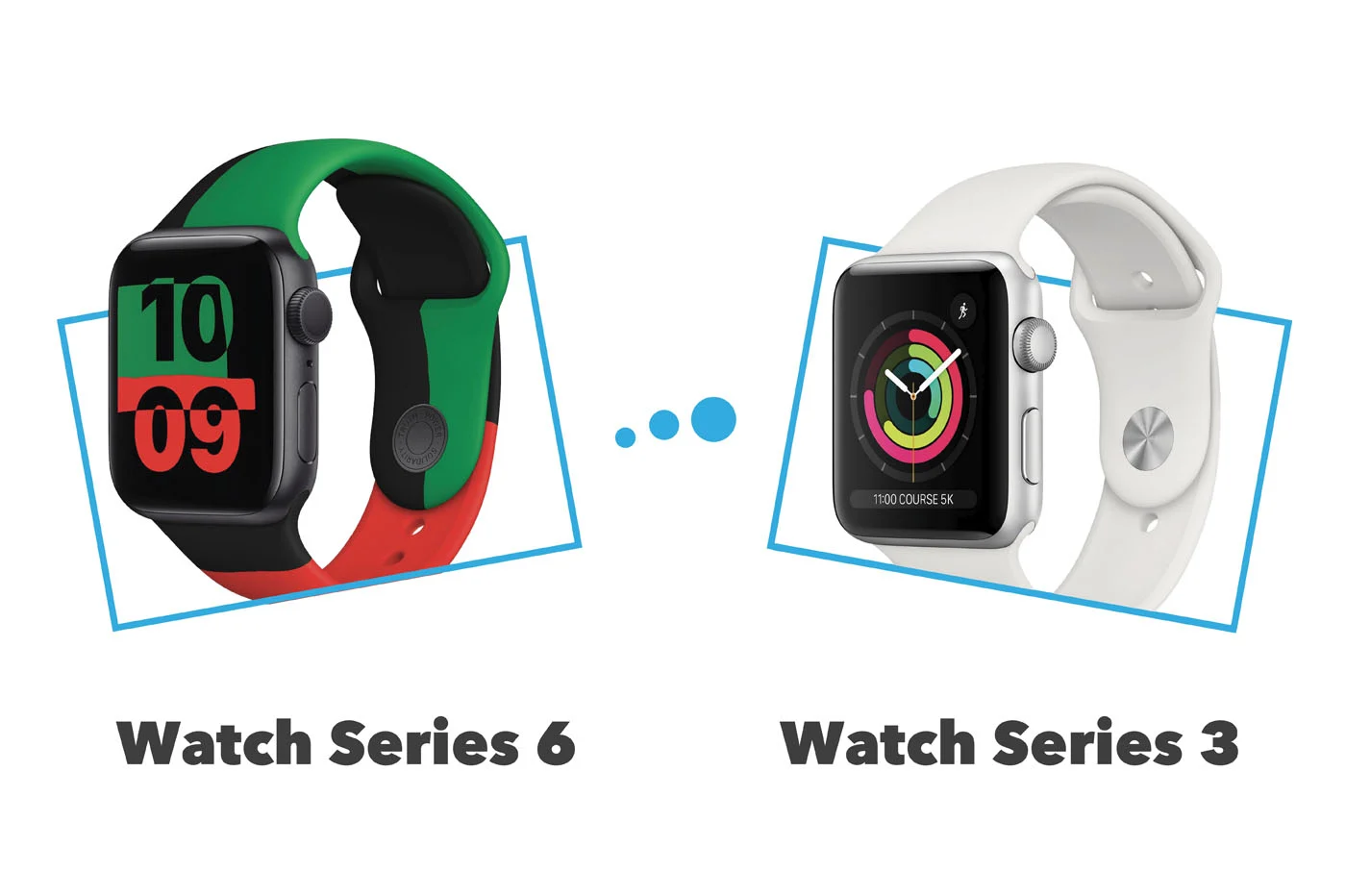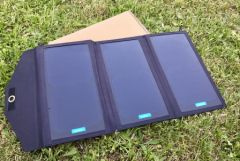With many advantages, VPNs have won over countless Internet users around the world. VPNs provide effective protection against the risks of cyberattacks and online surveillance. The software is also very practical when you go abroad or live in a country that censors Internet access. Sosome reasons that can explain why we use a VPN.
Is this type of application new to you and you don't know how to use a VPN? While VPNs are relatively simple tools to use, each application has its own characteristics. Fortunately, the method is similar from one VPN to another. We have therefore been able to group together the procedure to follow which will be valid most of the time. Here's a guide with everything you need to know to use a VPN correctly.
6400servers
111countries covered
30 dayssatisfied or refunded
10simultaneous connections
9.8/10
SEE MORE
1
3000servers
105countries covered
30 dayssatisfied or refunded
8simultaneous connections
9.4/10
SEE MORE
2
12000servers
100countries covered
45 dayssatisfied or refunded
7simultaneous connections
9.2/10
SEE MORE
3
Before using a VPN, one upstream step is essential: subscribing to the service. This seems logical but it is important to clarify it because you will not be able to use a VPN or activate it without first subscribing. If you don't know which provider to choose, you can rely on the comparison list above.
Learn How to Use VPN in Minutes
Let's get to the heart of the matter now by explaining how to use a VPN. First, we will quickly discuss the installation process so that you have no unpleasant surprises and can concentrate directly on the handling.
1) Download the file
First of all, it seems essential to download the software on your device. The easiest way to do this is to go to the supplier's official website and navigate to the section adapted to your operating system. If you want to install it on your iOS or Android smartphone or tablet, you can go directly to the corresponding application store (App Store or Google Play Store).
Don't forget to check that the version of your OS is supported by the service provider.
Once the download begins, you don't need to do anything special except follow the on-screen instructions. Typically, you will be guided through the installation. You will simply have to validate the different steps. Depending on the platform, you may be asked to validate the installation of new software by entering your computer password.
When the installation phase is completed, the VPN logo usually appears in the menu bar or taskbar.
2) Configure VPN on the device
When the software is downloaded, there is a very quick additional step to complete before finalizing the installation and being able to use the VPN. This is the configuration of the VPN – to be done only during the first connection or following an update.
From the freshly installed application which will normally open automatically, you will need to enter your connection details (e-mail address or username and passwords). This is the information you indicated when creating your account. Some providers do it differently and send you an activation code to copy/paste instead of the identifiers.
For installations on macOS, it is necessary to confirm the addition of VPN configurations to your Mac's network activity by clicking “Allow”. You will probably have to do the same with keychain access.
3) Enable VPN
Now all the technical aspects have been passed and you can start using your VPN. To achieve this, you will need to activate it by establishing a connection to a VPN server. To do this, simply click on the power button. And if the user interface is intuitive, you should get there very easily.
Generally, there are several ways to activate a VPN:
- either by choosing a location manually
- or using an automated login feature
You can set a manual connection by directly selecting the location of your choice from the list of countries. Some publishers offer multiple servers per location. In this case, you can establish a connection by selecting a server directly by clicking on it. The connection takes a few seconds. To save time, some VPN providers allow you to classify servers or locations as favorites. You will then be able to find the server in question very easily.
In case you do not want to obtain a specific virtual location but simply benefit from an encrypted and anonymous connection, it is possible to activate the VPN via the automation function. This is an option found with most providers. It is often clearly highlighted on the interface.
The only point to remember is that it can take a different name depending on the VPN. We are talking, for example, about Automatic Location for ExpressVPN, Best Server for CyberGhost or even Quick Connect at NordVPN.
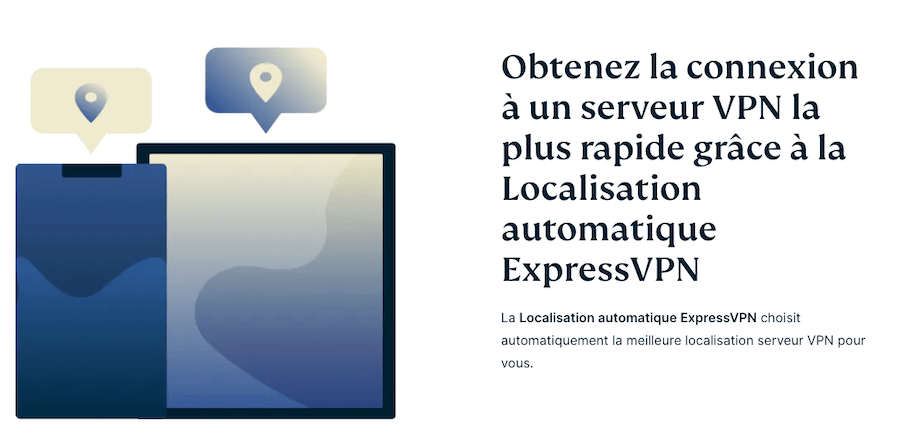
© ExpressVPN
The automatic connection selects the most appropriate server and country based on your geographic location, but also according to the internal load of remote machines on the network and their performance. The goal is to provide you with the best experience through optimal speed and protection.
Regardless of the connection method you choose, you should see “Connected” appear on the home screen to confirm VPN activation. All you have to do is browse the internet normally.
4) Disable VPN
When you no longer need to use your VPN, simply disconnect it by clicking the power button. Logically, you will be able to read the term “Disconnected” on the application.
Your source IP address will once again become visible on the web in the same way as your activities. For optimal security, be sure to disconnect the VPN only when you have finished browsing the internet.
5) Change VPN protocol
VPN protocols define the transmission method by which your device connects to the VPN server. In general, quality providers offer several. Among the most popular are OpenVPN, IKEv2, L2TP/IPsec and WireGuard. Each has its own characteristics.
OpenVPN is one of the most used. It is very fast and secure but is not compatible on all devices. IKEv2 is particularly suitable for mobile media. L2TP/IPsec is less effective at unblocking firewalls.
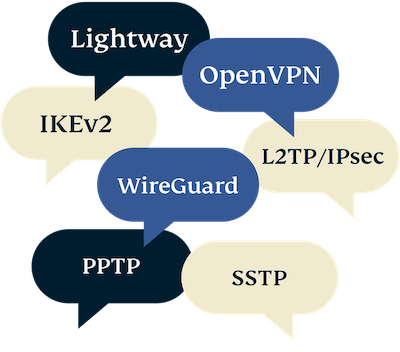
© ExpressVPN
Normally, you do not have to worry about these technical aspects since it is the provider who chooses the most suitable protocol according to the user's network. However, in some cases you may need to change the default VPN protocol – for example if your connection is slow or you are unable to establish a VPN connection.
Note that switching to another protocol can only be done when the VPN is disabled from the application settings.
6) Configure the VPN
This step is optional but it can still provide you with more comfort during daily use. You can therefore set a few parameters such as automatic connection as soon as your computer starts up or define which applications require VPN protection and which ones can do without it. This helps avoid conflicts when you use a local service and visit a foreign platform at the same time.
Of course, the settings vary by publisher. It's up to you to dig deeper by looking for what your service provider offers.
List of 3 Easiest VPNs to Use
Now that you know how to use a VPN in general terms, all that remains is to familiarize yourself with the technology by choosing a provider that, ideally, is easy to use. To help you, here are some recommendations for the easiest VPNs to use:
- ExpressVPN
- CyberGhost VPN
- NordVPN
- Surfshark VPN
- Private Internet Access
- Hide.me
ExpressVPN, the intuitive VPN par excellence
With ExpressVPN, no instructions are needed. The application interface is very intuitive. As you can see in the screenshot below, there are: power button, auto location, recent location and the full location list on the right.

Interface de l’application ExpressVPN © iPhon
You will therefore be able to connect to 105 countries in total and benefit from more than 3,000 servers. Locations are sorted by continent but you can also establish a connection from the recommended or recent locations tab. To disconnect the VPN, you don't need to follow any instructions either. Just click the power button again to go offline.
The settings are accessible from the hamburger menu at the top left of the application. In the preferences, you will have access to:
- general settings (to launch ExpressVPN at startup for example or activate Network Lock)
- to VPN protocols
- to account information
- to advanced settings (IPv6 leak protection, DNS, appearance)
The ExpressVPN application is very well designed: every term that may seem technical is defined. To use ExpressVPN, you will therefore not need any special knowledge. Just remember that Network Lock (also called Kill Switch) is a very useful feature to protect you in the event of an unexpected VPN disconnection.
If you still want to learn more about the subject, the VPN provider provides tutorials in video format illustrating the procedure to follow to use it. Also,our full review of ExpressVPNshould help you.
To discover ExpressVPN, you can count on its money-back guarantee allowing you to test the VPN risk-free for 30 days.
CyberGhost, the VPN application accessible to all
CyberGhost is another VPN player known for the ease of use of its tool. With it, you won't be lost – even if you're just starting out.
From the first glance, it is quite easy to navigate thanks to an uncluttered interface and tabs grouping the different types of servers available (favorites, standard servers, dedicated IP, those for downloading and others for streaming) . The easily identifiable connection button makes it simple to activate the VPN without asking any questions.
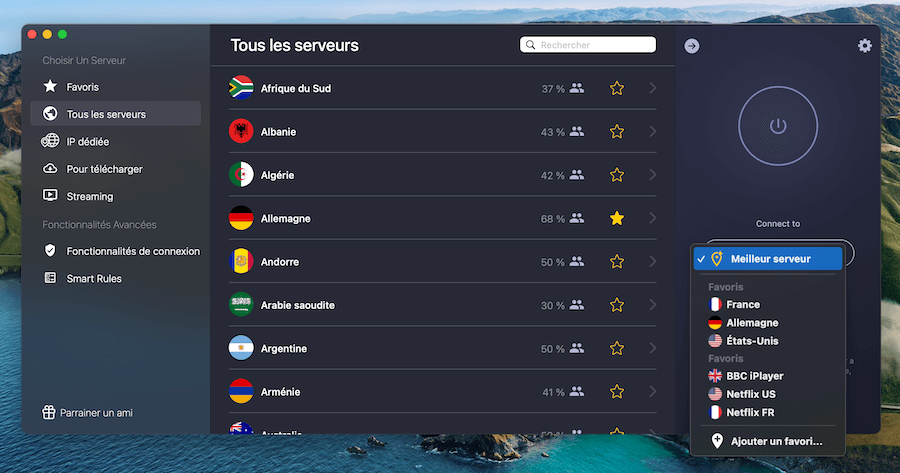
CyberGhost application interface © iPhon
By clicking on the drop-down menu located under the button, you will have quick access to your servers classified in favorites and to the Best Server option which allows an automatic and optimized connection. Otherwise, you can choose from the more than 6,800 servers and 89 countries in which CyberGhost is present.
The technical parameters can be found in the toothed wheel at the top right. It's there, from the general preferences that you can change the VPN protocol.
From the Connection Features tab, it is possible to activate additional layers of protection such as the ad and malicious site blocker, data compression, online anti-tracking and automatic HTTPS redirection. If you are looking for the Kill Switch feature, know that you don't have to worry about it as it is built in by default.
You will see for yourself, there is no difficulty when using CyberGhost VPN. If you still have questions, you can ask them in French to technical support available 24 hours a day, 7 days a week.
NordVPN, the well-designed VPN application
If you are looking for an easy-to-use VPN, you can also look at NordVPN. Like its two competitors mentioned above, it provides a user-friendly VPN application that is very well thought out and adapted to all user profiles. The very nice design of the application is an additional asset.
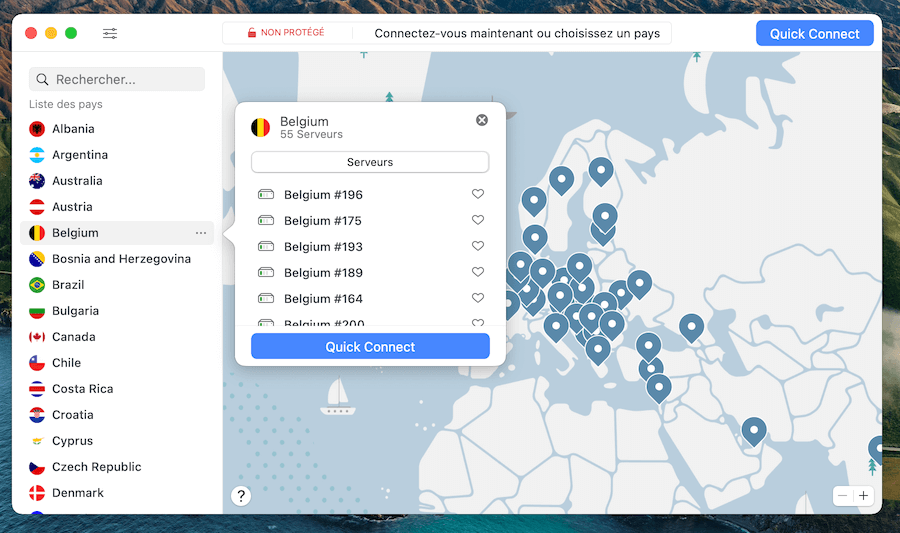
Interface de l’application NordVPN © iPhon
On the interface, you will therefore have direct access to the list of available countries. In total, NordVPN has more than 5,500 servers spread across 59 countries around the world. The number of servers is detailed for each location so that you can choose precisely the one to which you want to connect. For a random and optimized connection, click on the “Quick Connect” button.
By clicking on the settings icon at the top left of the interface, you can modify the system preferences and choose:
- to launch the VPN when the computer starts or not
- activate the anti-malware filter and ad-block
- the VPN protocol
- the appearance
By default, the Kill Switch function is automatically activated like CyberGhost does in order to guarantee your protection at all times.
No need to follow any guidelines to use NordVPN. It only takes a few minutes to familiarize yourself with the interface and establish a secure connection between your device and a server.
FAQs on Using VPNs
So that you are knowledgeable about the use of VPNs, let's conclude this article with a series of questions/answers on this subject.
How to use a VPN?
To activate a VPN and browse securely, simply click on a location, a server or the power button from the application interface. Disconnection is done by clicking again on the main button.
Which VPN protocol to choose?
The choice of protocol is generally self-managed by the VPN provider. Generally, the most suitable on all networks is OpenVPN. Depending on the circumstances, IKEv2 may also be an option. WireGuard is preferred for optimal speed.
What to do if the connection is interrupted?
If your VPN cuts out, you can close the app and restart it. If this does not solve the problem, changing the VPN protocol may be an option. In any case, check that the Kill Switch is activated to prevent your IP address from leaking.
On which devices can you use a VPN?
Premium VPNs are compatible on several platforms. You can therefore use a VPN on a computer, smartphone, tablet, television and connected box and even on routers sometimes. The most popular operating systems are covered.
Can you use a VPN on multiple devices?
Most of the time, it is possible to use a VPN on multiple devices at the same time thanks to the simultaneous connections provided by VPN providers. It is therefore important to check this number before subscribing.
What are the disadvantages of using a VPN?
The main disadvantage of a VPN is that it will slow down your internet speeds. Now there is nothing to be afraid of. By opting for VPNs likeExpressVPN,CyberGhostorNordVPN, your Internet speeds will only be slightly impacted.
The other disadvantage concerns the 100% free services. A large majority of them are not reliable and secure. They will therefore endanger your security and your anonymity on the Internet, which no one wants.
Finally, it is worth noting that in some countries it is difficult to use a VPN because these services are often blocked. China, Russia and Belarus, for example, are putting in place quite a few measures to prevent their use. If you wishmore information regarding countries where VPNs are illegal, we advise you to read our dedicated article.
Is there no point in using a VPN?
Absolutely not. There is no shortage of reasons to use such a service: better Internet security, unblocking normally blocked sites, access to exclusive content on streaming services, watching French TV channels abroad, or even downloading. Totally secure (and anonymous) P2P.
Did this convince you? So take the time to read our guide explaining how to use a VPN to get started!
How to use a VPN on a smart TV?
Contrary to what you might think, using a VPN on a connected TV is not necessarily complicated. This is especially true if your smart TV is powered by Android TV. Is this your case? So you will just have to go to the Google Play Store from your television, search for the VPN you have just subscribed to, download its application, then log in to your customer account.
After that, you can use the VPN on your Android TV as if you were on a computer, smartphone or tablet.
If your connected TV doesn't work with Android TV, you'll have to be tricky. You can either configure your VPN on your Internet router (provided that it is supported) or connect via HDMI to a computer on which you will activate the protection.


